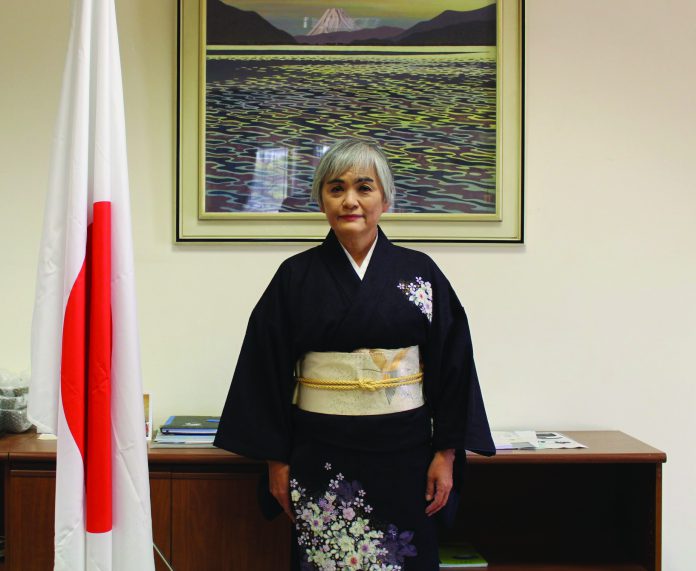
BY ITO TAKAKOኘ Ambassador of Japan to Ethiopia
On March 11, 2011, a 9.0 magnitude earthquake hit the eastern part of Japan. Soon after came large-scale tsunamis, some of which were over 10 meters high, subsuming coastal towns in various locations several times and destroying many areas, claiming many human lives. Death tolls amounted to nearly 20,000, including about 3,800 people who had survived the earthquakes and tsunamis but lost their lives in the deteriorated living conditions that followed afterwards. Nearly 2,600 people are still missing even today. Over 120,000 houses were completely destroyed and 470,000people were forced to evacuate. As a result, many communities disintegrated. The unbearable sadness of suddenly losing loved ones, and the fear of the huge nuclear disaster from the Fukushima Nuclear Plans swept over the country.
Infrastructures, including roads, railways, electricity grids, schools and hospitals were destroyed. Then there was a huge challenge to access the disaster-stricken areas and distribute food and medical provisions to the people in need. In some cases, the capacity of municipality offices, mayors and officials were all diminished due to the tsunami water, leaving survivors without their decision makers or a place to evacuate in the cold weather. Industrial facilities, farmland and sea farms were also destroyed. Indeed, photos of the affected areas immediately after the tsunami looked like the scenes from a war-zone.
At the depth of our desperation, we the Japanese people received a large amount of assistance from all over the world, including from Ethiopia. Although Japan is geographically far apart from this country, and Ethiopia itself had various challenges itself, including poverty eradication and accepting huge numbers of refugees from neighbouring countries, the goodwill of the people of Ethiopia reached Japan. I think most of the Ethiopians knew nobody in Japan, but they shared the pain and hardships of those who were starving and freezing in the snowy weather in Japan and extended their warm friendship. On behalf of the people and the Government of Japan, I would like to express our deepest appreciation for the kind help that was sent from Ethiopia out of their compassion and solidarity with the Japanese people. We will never forget the genuine friendship expressed by Ethiopia at a time of great difficulty for Japan.
The road to reconstruction since the disaster has not been an easy one, and it is yet to be completed. The COVID-19 pandemic has added even more complications on our journey toward reconstruction. Nevertheless, thanks to the hard work and perseverance of all who were involved in reconstruction, including countless volunteers, as well as assistance from the Japanese people and from the international community, Japan can now show the world many of its achievements that have occurred over the last 10 years.
As for the reconstruction of housing, approximately 30,000 public housing units have been constructed and the development of residential land with relocation to upland has been completed, containing approximately 18,000 units. About 154,000 units of independent reconstruction, for which the Japanese Government provided support grants for victims to rebuild their homes, were also finished. Currently 91% of former evacuees have moved to new housing, and only about 2,000 people remain in temporary housing. Physical and mental health care and monitoring by counselors are now being provided to support evacuees.
Schools and hospitals have mostly been rebuilt, and the disposal of debris and the restoration of infrastructure are mostly complete. Shipments of manufactured products from the three most severely hit Prefectures (Iwate, Miyagi and Fukushima) have recovered to the level before the earthquake. 94% of farmland affected by the tsunami has recovered and 97% of seafood processing facilities have reopened.
This year the Tokyo 2020 Olympic and Paralympics Games will take place, and these Games will also serve as the ‘Reconstruction Olympics and Paralympics”. We will use this opportunity to show the world the status of the reconstruction of the disaster-stricken areas, as well as to support the further reconstruction of these areas. Some events will be held in these areas, such as football games in Miyagi Prefecture, and baseball and softball games in Fukushima Prefecture. The Olympic Torch relay will start on 25 March from the National Training Center J- Village in Fukushima Prefecture, which was once used as a base for cleanup efforts after the Fukushima Daiichi nuclear disaster. The Flame of Reconstruction will be carried through the disaster-affected areas. Furthermore, delicious food from the three prefectures will be provided to competitors at the Athletes’ Village, and flowers from these areas will be arranged for Victory Bouquets given to all medalists. I hope many of these bouquets will be awarded to Ethiopian athletes.
We have learned many lessons from this national calamity. One of the most important is that disaster preparedness cannot be over-emphasized. Education and repeated training sessions of what to do in times of disaster proved to be crucial for saving lives, especially for children. The establishments of wider networks among communities across the country and at different levels of government, which will help ensure the command centers for rescue and response activities function properly, have been enhanced. Fast response and mobilization of a large number of people are critical to save lives. Infrastructure and various facilities have been reevaluated to ensure that they are strong enough to resist forces bigger than those estimated in a conventional method. The need to incorporate a more gender sensitive perspective, as well as to provide mental health care for survivors, have been recognized and addressed.
We will share these lessons with the international community in order to reduce casualties caused by natural disasters. This will be one way of showing our gratitude and return the kindness exhibited by the people who helped us ten years ago, including those in Ethiopia.





